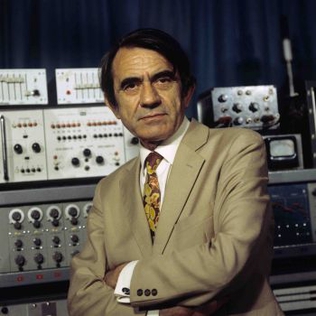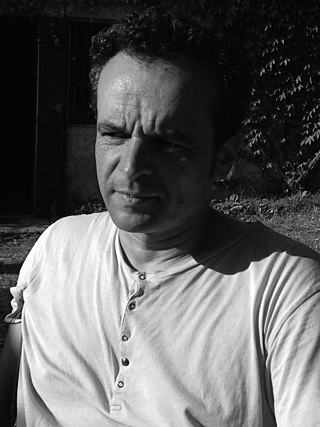Related Research Articles
Musique concrète is a type of music composition that utilizes recorded sounds as raw material. Sounds are often modified through the application of audio signal processing and tape music techniques, and may be assembled into a form of sound collage. It can feature sounds derived from recordings of musical instruments, the human voice, and the natural environment as well as those created using sound synthesis and computer-based digital signal processing. Compositions in this idiom are not restricted to the normal musical rules of melody, harmony, rhythm, and metre. The technique exploits acousmatic sound, such that sound identities can often be intentionally obscured or appear unconnected to their source cause.

Pierre Henri Marie Schaeffer was a French composer, writer, broadcaster, engineer, musicologist, acoustician and founder of Groupe de Recherche de Musique Concrète (GRMC). His innovative work in both the sciences—particularly communications and acoustics—and the various arts of music, literature and radio presentation after the end of World War II, as well as his anti-nuclear activism and cultural criticism garnered him widespread recognition in his lifetime.

Luc Ferrari was a French composer of Italian heritage and a pioneer in musique concrète and electroacoustic music. He was a founding member of RTF's Groupe de Recherches Musicales (GRMC), working alongside composers such as Pierre Schaeffer and Pierre Henry.
Acousmatic sound is sound that is heard without an originating cause being seen. The word acousmatic, from the French acousmatique, is derived from the Greek word akousmatikoi (ἀκουσματικοί), which referred to probationary pupils of the philosopher Pythagoras who were required to sit in absolute silence while they listened to him deliver his lecture from behind a veil or screen to make them better concentrate on his teachings. The term acousmatique was first used by the French composer and pioneer of musique concrète Pierre Schaeffer. In acousmatic art one hears sound from behind a "veil" of loudspeakers, the source cause remaining unseen. More generally, any sound, whether it is natural or manipulated, may be described as acousmatic if the cause of the sound remains unseen. The term has also been used by the French writer and composer Michel Chion in reference to the use of off-screen sound in film. More recently, in the article Space-form and the acousmatic image (2007), composer and academic Prof. Denis Smalley has expanded on some of Schaeffers' acousmatic concepts. Since the 2000s, the term acousmatic has been used, notably in North America to refer to fixed media composition and pieces.
Horacio Vaggione is an Argentinian composer of electroacoustic and instrumental music who specializes in micromontage, granular synthesis, and microsound and whose pieces are often scored for performers and computers.
Acousmatic music is a form of electroacoustic music that is specifically composed for presentation using speakers, as opposed to a live performance. It stems from a compositional tradition that dates back to the origins of musique concrète in the late 1940s. Unlike acoustic or electroacoustic musical works that are realized from scores, compositions that are purely acousmatic often exist solely as fixed media audio recordings.

Pierre Georges Albert François Henry was a French composer and pioneer of musique concrète.
François Bayle is a composer of Electronic Music, Musique concrète. He coined the term Acousmatic Music.

Christian Zanési is a French composer.

Patrick Ascione was a French composer of electroacoustic and acousmatic music.
Gérard Patris was a French film director and television director who died in a car accident in 1990 in Chailles. His works include the documentary film Arthur Rubinstein – The Love of Life.
Michèle Bokanowski is a French composer. She was born in Cannes, and was educated in traditional music. She continued her studies in composition in Paris with Michel Puig and in electronic music in 1970 at the Service de la recherche de l’ORTF (ORTF) directed by Pierre Schaeffer. She also studied computer music at the Faculté de Vincennes and electronic music with Eliane Radigue.
Musique(s) électronique(s): les bruitistes et leur descendance is a documentary film shot between 2010 and 2012 by filmmaker Jérémie Carboni.
The Studio d'Essai, later Club d'Essai, was founded in 1942 by Pierre Schaeffer, played a role in the activities of the French resistance during World War II, and later became a center of musical activity.
Nicolas Vérin is a French composer and professor of music. His many influences, from jazz to electronics, from American to French music, give him an unusual style, apart from the main trends of French contemporary music, combining energy and subtleness.

This is a bibliography of articles and books by or about the director and film critic Jacques Rivette.
Makis Solomos is a Franco-Greek musicologist who specializes in contemporary music, particularly the work of Iannis Xenakis. He is also one of the specialists of Adorno's thought. His work focuses on the issue of sound ecology and decay. He has published articles and books and participates in meetings and symposia. In 2005, he participated in the creation of the magazine "Filigranes", which aimed to broaden the field of musicology.
Norbert Stéphane Jean-Marie Dufourcq was a French organist, music educator, musicologist and musicographer.

Jean-Baptiste Favory is a French sound artist and composer of musique concrète, electronic and instrumental music.

Alexis Galpérine is a French classical violinist.
References
- ↑ Chion, Michel (1994–2005). Audio-Vision: Sound on Screen. Translated by Claudia Gorbman. New York: Columbia University Press. ISBN 0-231-07898-6.
- ↑ Chion, Michel (1990). L'audio-vision. Son et image au cinéma. Paris: Editions Nathan. ISBN 978-2-09-190885-4.
- ↑ Daniele, Romina (2011). Ascenseur pour l'échafaud, Il luogo della musica nell'audiovisione. Milan: RDM. pp. 13–14. ISBN 978-88-904905-9-0.
- ↑ Elisabeth Weis; John Belton (1985). Film sound: theory and practice. Columbia University Press. ISBN 978-0-231-05637-3.
- ↑ Gilbey, Ryan (10 August 2010). "Gilbey on Film: what's in a voice?". New Statesman . Retrieved 31 August 2010.